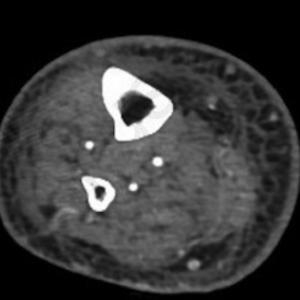An unusual case of Escherichia coli cellulitis and bacteremia in an immunocompetent patient

HTML: 20
All claims expressed in this article are solely those of the authors and do not necessarily represent those of their affiliated organizations, or those of the publisher, the editors and the reviewers. Any product that may be evaluated in this article or claim that may be made by its manufacturer is not guaranteed or endorsed by the publisher.
Cellulitis secondary to Escherichia coli (E. coli) is a rare phenomenon, particularly in an immunocompetent patient. We report an unusual case of an immunocompetent 84-year-old female presenting with E.coli bacteremia and E. coli cellulitis in the right lower leg. We postulate that bacterial translocation from the gastrointestinal tract to the bloodstream is the most likely source of E. coli infection. Whilst a common condition, cellulitis can pose a diagnostic and therapeutic challenge when a causative organism is not identified. Thorough investigation and consideration of atypical organisms such as E.coli are essential to permit targeted antimicrobial therapy and prevent patient deterioration.
2. Kaper JB, Nataro JP, Mobley HLT. Pathogenic Escherichia coli. Nature Reviews Microbiology. 2004;2:123-140.
3. Buchanan R, Stoesser N, Crook D, Bowler IC. Multidrug-resistant Escherichia coli soft tissue infection investigated with bacterial whole genome sequencing. BMJ Case Rep. 2014;2014.
4. Yang S, Jiang WM, Yang HL. ALK-positive anaplastic large cell lymphoma of the thoracic spine occurring in pregnancy: A case report. World J Clin Cases. 2019;7:2857-2863.
5. Raff AB, Kroshinsky D. Cellulitis: A Review. JAMA. 2016;316:325-337.
6. Yoon TY, Jung SK, Chang SH. Cellulitis due to Escherichia coli in three immunocompromised subjects. Br J Dermatol. 1998;139:885-888.
7. Janny S, Bert F, Dondero F, et al. Fatal Escherichia coli skin and soft tissue infections in liver transplant recipients: report of three cases. Transpl Infect Dis. 2013;15:E49-53.
8. Pasini E, Aquilani R, Testa C, et al. Pathogenic Gut Flora in Patients With Chronic Heart Failure. JACC Heart Fail. 2016;4:220-227.
9. Mortimer PS. Cellulitis in chronic oedema. Br J Dermatol. 2021;185:10-11.
10. Chira S, Miller LG. Staphylococcus aureus is the most common identified cause of cellulitis: a systematic review. Epidemiol Infect. 2010;138:313-317.
11. Leppard BJ, Seal DV, Colman G, Hallas G. The value of bacteriology and serology in the diagnosis of cellulitis and erysipelas. Br J Dermatol. 1985;112:559-567.
Copyright (c) 2022 the Author(s)

This work is licensed under a Creative Commons Attribution-NonCommercial 4.0 International License.
PAGEPress has chosen to apply the Creative Commons Attribution NonCommercial 4.0 International License (CC BY-NC 4.0) to all manuscripts to be published.





 https://doi.org/10.4081/dr.2023.9603
https://doi.org/10.4081/dr.2023.9603



